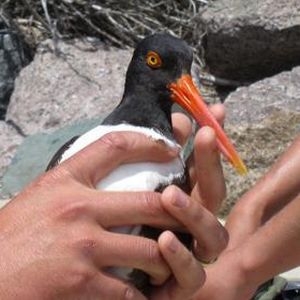
(Host) As the oil disaster in the Gulf of Mexico continues, scientists and wildlife conservationists are warning that large numbers of birds could be lost. In addition to native species such as the Brown Pelican, there are concerns about other shorebirds such as those currently nesting in and around the northeast. Some of those bird will migrate to the Gulf by the end of the summer.
As part of a collaboration with Northeast stations, MPBN’s Susan Sharon reports, efforts are underway to track these birds and to mitigate for a far-reaching disaster.
(Sharon) On a sparkling blue morning on some rocks along Stony Point Dike in the Cape Cod Canal, a pair of adult Oystercatchers are caring for a young chick. Like nervous new parents, they take turns flying off in search of food and bringing it back. Watching through binoculars about 30 yards away are Shiloh Schulte from the Massachusetts-based Manomet Center for Conservation Sciences and Katy Forgues from City University of New York who’ve set a trap for the birds.
(Shiloh Schulte) "And here they’re walking towards the decoy now which is exactly what we want them to do. They should go across our trap and at least one of them should get caught. Here they go. This is exactly what we want."
(Sharon) The decoy looks just like an American Oystercatcher: yellow, red-rimmed eyes, white belly, black cape, brown back and a long, bright reddish-orange beak — a knife-like beak that makes it easier to pluck the meat out of oysters and clams. The decoy is placed on a camouflaged carpet of fishing line nooses next to a portable tape machine playing a recording an alarmed oystercatcher that sounds like this:
(bird call)
(Sharon) Schulte says Oystercatchers are smart, territorial and will often charge the perceived invader, aggressively stamping their feet and bobbing their heads up and down to defend their turf.
(Shiloh Schulte) "What we’re trying to do today is catch an Oystercatcher or two and put individual bands on them which we can read with binoculars and so we can actually track survival rates year to year. We can track migration. And this really aids the ultimate goal which is conservation of the species."
(Sharon) Schulte says there are only about 10,000 of the birds in the United States. Around the Northeast, some of the largest populations are found in Massachusetts and New York. Many of these birds will spend their winters in the Gulf in an area north of Tampa Bay. And because they return to the same spot every year, Schulte expects to lose as much as 20 percent of the oystercatchers to the Gulf oil spill.
(Meredith Gutowski) "This is something I’m working on. I think we’re in here."
(Sharon) Meredith Gutowksi is a conservation specialist with the shorebird recovery project at Manomet where she focuses not just on the Oystercatcher, but other shorebirds. She says about 40 species pass through the Gulf region. About half of those are considered a high priority for protection because of threats from habitat degradation, development and climate change.
(Meredith Gutowski) "We have a species-specific action plan and it lists the primary threats to that species and it also lists where the most important sites are for that species."
(Sharon) Using a voluntary network of federal and state agencies, private landowners and others in the field, the sites are ranked by population. The more birds that congregate, the more important the site. Along the Texas Gulf Coast, there are five with an international designation. That means they support populations of at least 100,000 birds. Information about where and when the birds go has been uploaded to a Google Earth map that includes the Gulf Coast where the same voluntary network on the ground can plan for what’s ahead.
(Meredith Gutowski) "I just clicked on the Grand Terr Island areas and we’ve got Wilson’s plover, Dunlin, Marbled Godwit – they’ll be migrating through this fall."
(Sharon) Gutowski says birds with long beaks that eat shellfish such as the Oystercatcher or birds that dig deep into the sand will be contaminated by the oil spill long after the well is finally capped. That gives those on the ground a short window to put booms in place, undertake clean up of beaches and protection of habitat that has not been affected by the oil spill.
Meanwhile, back on Stony Point Dike, an Oystercatcher has been caught in the trap and is being banded, measured and weighed.
(Katie Forgues) "It seems pretty skinny."
(Shiloh Schulte) "It’s 510 grams so this is a very skinny bird. Mr. Skinny, that’s it. That’s what he’ll be from now on."
With any luck, Schulte says Mr. Skinny will avoid the oil soaked Gulf and come back to this same beach in Cape Cod to nest for the next 20 years.
For VPR News, I’m Susan Sharon.
(Host outro) Northeast environmental coverage is part of NPR’s local news initiative. The reporting is made possible, in part, by a grant from United Technologies.